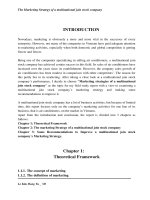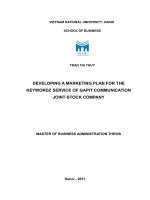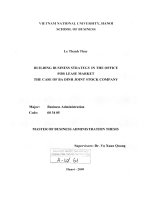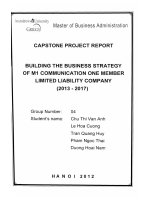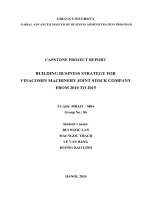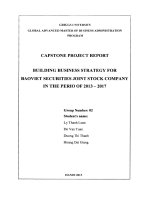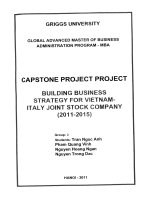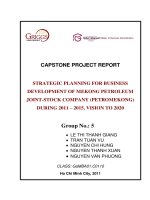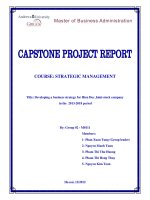LV Thạc sỹ_Perfect the business strategy of Nhung Ceramics Joint Stock Company
Bạn đang xem bản rút gọn của tài liệu. Xem và tải ngay bản đầy đủ của tài liệu tại đây (2.5 MB, 90 trang )
GRIGGS UNIVERSITY
GLOBAL ADVANCED MASTER OF BUSINESS ADMINISTRATION PROGRAM
CAPSTONE PROJECT REPORT
SITUATION AND SOLUTIONS FOR NHUNG CERAMICS JSC
TO IMPROVE BUSINESS STRATEGIES
Group No.:4
Student’s name:
Pham Thi Mai Ly
Pham Thi Nhung
Nguyen Đinh Nhuan
Đang Van Tuan
HANOI, 2009
Subject: Perfect the business strategy of Nhung Ceramics Joint Stock Company
INTRODUCTION
1. Urgency of the subject
The first thing we mention the importance of business strategy. Indeed, an
organization in general or in particular business to succeed needs to be able to cope
with any situation, be completely autonomous, decide and take responsibility for all
their activities. Therefore, requires organizations to understand the trends are
changing, that exploit the strengths and reduce the weakness to create innovative
step for you, in other words to build them a suitable strategy.
Can say the role of business strategy is becoming especially important for business
especially in terms of economic integration, production level and increasing
competitiveness in the increasingly fierce market. In fact, many enterprises in
Vietnam has not really interested in the formulation of strategies for them.
In recent years, when Vietnam opens its economy, promote the export of thousands
of businesses are established and take a new look for the economy, businesses of
diverse industries enough, enough fields in which traditional industries, handicrafts,
especially pottery manufacturing enterprises contributed an important role in
national economic structure.
From ancient pottery to date are associated with living art, pottery has become a
witness to the lives of people; it changes in sign of economic social cultural and
religious history at each stage country. In many ceramic kilns across the country,
Phu Lang pottery kiln is still a familiar name to people our country with several
hundred pottery kilns of which Nhung Phu Lang pottery known and famous both at
home and abroad.
Production units Nhung Phu Lang pottery has established a joint stock company
Nhung Pottery, started its operations in 2002 with initial membership of 40
members of the village of ceramic artisans, Director is Nhung Vu Huu, now the
2
basis of the number has grown up to 800 workers, skilled workers so that more and
more sophisticated products, profits yearly rise.
Vu Huu Nhung, 33 years old born and grew up in Phu Lang village, he graduated
from the University of Industrial Arts in 1997. Unlike other students who stay in
Hanoi, after his graduation, he returned home Nhung has returned homeland to start
his career by the crafts of traditional handicraft village.
Nhung ceramics joint stock company located 20km north of Hanoi, where we will
be witnessed the process of making pottery, and we understand why he choose this
profession. He is a talented artisan pottery, he had the idea of making ceramic
products in its traditional beauty of the Vietnamese soul. Over many generations,
Phu Lang village only make simple products such as: vases, peace, jar, coffin and
other common households. He is a pioneer in creating ceramic art products, brings
the brand name for Phu Lang pottery village.
In Phu Lang today,there are many small pottery kilns with small business, Nhung is
only kiln which make valuable artproducts.There were vases, the bottle contained
creactivity and unique style and design, and they have been exhibited in many
galleries in Hanoi and Ho Chi Minh. These products have brought many valuable
not only known in the country but also attract attention, favorite friends all over the
world (The USA and EU).
Since its establishment (2002). Nhung Ceramics Joint stock company tends to make
use of methods of strategic management in business management and in fact, has
brought good results.
With awareness of the importance of planning business strategies in the business we
boldly choose project "Perfect the business strategy of Nhung Ceramics Joint Stock
Company stage 2010 - 2015" in order to put knowledge to Business Reality.
2. Research problems
-
Factors in the external environment impact the construction business strategy.
-
The elements of internal enterprise impact on the construction business
strategy.
3
-
Analysis and assessment of general state construction business strategy of
Nhung Ceramics Joint Stock Company.
-
Orientation business strategy for 2015 includes joint stock company based on a
combination of theoretical and practical analysis.
3. Objective study
Perfect strategic fit of business enterprises in the period from now to 2015.
4. Scope of research
Analyze the business environment and consider the factors to the success of the
company in recent years for business-oriented strategy on the domestic market and
abroad in 2015.
5. Methodological
Major exercises using secondary sources and primary as follows:
-
Collecting data through secondary sources such as newspapers, internet,
distribution channels, internal documents ...
-
Collecting primary data: Using the method of quantitative and qualitative data
collection to record levels.
-
Using a statistical analysis method to analyze the primary data collected.
-
Interview with the members of the company's leadership as Chairman,
members of the Board, Director, ... the development orientation of the
company in the future.
6. The contribution of major exercises
-
Systematize a number of theoretical basics of business strategy;
-
Analysis and assessment of general state construction business strategy of
Nhung Ceramics company.
-
Propose a complete solution to build business strategy at Nhung JSC.
7. Structure of great exercises
-
Chapter 1: Basical arguments of business strategy
-
Chapter 2: Situation of business strategy of Nhung ceramics joint stock
company includes the last time.
4
-
Chapter 3: Solutions for Nhung ceramics JSC to improve business strategies
the period 2010 - 2015.
TABLE OF CONTENTS
Acknowledgements
Table of content
Introduction ...........................................................................................................................................6
Chapter 1: BASICAL ARGUMENT OF BUSINESS STRATEGY ...............9
1.1.
1.2.
1.3.
1.4.
1.5.
Basical concepts .................................................................................9
Vision, Mission and core competencies ..............................................10
Strategic management .........................................................................11
Strategy formulation ..........................................................................14
Selecting and implementing strategy .................................................23
Chapter 2: SITUATION OF BUSINESS STRATEGY OF NHUNG
CERAMICS JOINT STOCK COMPANY INCLUDE LAST TIME ........29
2.1. Introduction .........................................................................................29
2.2. Commitment to business strategies in the last few years .....................34
2.3. Analysis of macro-environment ...........................................................34
2.4. The assessment of competitive ability of the Company ......................45
2.4.1. Analyzing industry environment ............................................... 45
2.4.2. Evaluation of company’s strong and weak points ......................50
2.4.3. Evaluation of the business outstanding competence ...............55
2.4.4. Analysis of value range ...........................................................56
2.4.5. SWOT matrix ............................................................................59
2.5. The current business strategy ...............................................................61
2.6. The current organization and controlling mechanism ............................61
2.7. Nhung Ceramics's position in the market .............................................63
Chapter 3: SOLUTIONS FOR NHUNG CERAMICS JSC TO IMPROVE
BUSINESS STRATEGIES THE PERIOD 2010 – 2015 ............................65
3.1. Some orientation in formulating the Company’s strategy ....................65
3.2. The Company’s development directions .............................................68
5
3.3. Targets and strategy for the period 2010-2015 ..................................69
3.3.1. External environment analysis .................................................70
3.3.2. Internal environment analysis ....................................................71
3.3.3. SWOT matrix ...........................................................................72
3.3.4. Business strategy for the period 2010 – 2015 ...........................78
3.3.4.1. Organizational structure ............................................78
3.3.4.2. Competition and investment strategy ..........................79
3.3.4.3. Business strategy ........................................................81
3.4. Strategic solutions .............................................................................84
3.4.1. Strategic solutions in production and technology ..................84
3.4.2. Strategic solutions in finance ..................................................85
3.4.3. Strategic solutions in HR and organizational structure ........... 85
3.4.4. Strategic solution in marketing ...............................................86
3.5. Implementation ............................................................................... 87
3.5.1. GANTT chart .......................................................................87
3.5.2. Organization for implementation ..........................................89
CONCLUSION AND RECOMMENDDATION ......................................90
REFERENCES ..............................................................................................91
APPENDICES ...............................................................................................92
6
List of tables
Table 1.1 – SWOT matrix
Table 1.2 – Strategy implementation
Table 2.1 – Table of general analysis on macro-economic environment
Table 2.2 – Result summary of five competitive forces model analysis
Table 2.3 – Evaluation of company’s strong and weak points
Table 2.4 – Evaluation of the company’s outstanding competences
Table 3.1 – Table of assessment of business environment factors
Table 3.2 – The table of assessing key internal factors
Table 3.3 – Sum up table of assessments under SWOT matrix
Table 3.4 – Table of results under the GREAT model
Table 3.5 – the Company’s targets for 2010 - 2015
Table 3.6 – Gantt chart
7
List of figures, graphs…
Figure 1.1 – The strategic management process
Figure 1.2 – Step in planning strategy
Figure 1.3 – The external environment analysis model
Figure 1.4 – Industry environment analysis model
Figure 2.1 – The company’s organizational structure and Board of
management
Figure 2.2 – the Company’s revenue from 2002 to 2008
Figure 2.3 – Vietnam export ceramics market
Figure 2.4 - Market of company
Figure 3.1 – Organizational structure
Figure 3.2 – GE matrix model
Figure 3.3 – Types of potential competitive advantages
8
CHAPTER 1
BASICAL ARGUMENT OF BUSINESS STRATEGY
1.1. Basical concepts
1.1.1. Concept of strategy
The word "strategy" has military connotations, because it derives from the Greek
word for general. According to American Encarta, a strategy is the art and science
of military management. It is a plan of action designed to achieve a particular goal.
According to Larousse Dictionary, strategy is the mean or the tool by which
objectives are consciously and systematically pursued and obtained over time.
The strategy definition most commonly known today as in business environment –
business strategy. The word "strategy" has been used implicitly in different ways
even if it has traditionally been defined in only one. Explicit recognition of multiple
definitions can help people to manoeuvre through this difficult field. Mintzberg
provides five definitions of strategy:
Plan
Strategy is a plan - some sort of consciously intended series of action
Ploy
Strategy is a ploy, really just a specific manoeuvre intended to outwit competitor.
Pattern
Strategy is a pattern - Show the firms and behaviour of the company till time. .
Position
Strategy is a position - means the match betweem company and its environment.
Perspective
Strategy is a perspective Show the awareness of the leaders
Match the different definitions about business strategy, we can see that “a
coordinated series of actions which involve the deployment of resources to which
9
one has access for the achievement of a given purpose.” (a lecture of Griggs
University)
1.1.2. The Strategic Management Process
Involves the full set of:
Figure 1.1 - The Strategic Management Process
(According to: The lecture on the strategy management - Griggs University)
A set of decisions and actions the CEO and lower-level managers use to gain a
general commitments. Traditional process of strategic management – responsibility
of the CEO is out of date. But a multi-level strategic management system is
replaced with the same goal in the action to carry out the business strategy.
Therefore, the primary commitments will be the key factors of the whole system.
1.2. Vision, mission and core value
The first step of strategic management process is the firm’s commitments. It is the
process of specifying the firm's mission, vision and core values, which are designed
to achieve these objectives.
-
Vision: Defines the desired or intended future state of a firm in terms of its
fundamental objective and/or strategic direction. Vision is a long-term view.
10
-
Mission: Defines the fundamental purpose of a firm, basically describing why
it exists and what it does to achieve its vision.
-
Core values: Core values are resources and capabilities that can serve as a
source of Competitive Advantage.
1.3. Strategic management
Identifying strategic groups equivalently to the firm’s defined strengths,
weaknesses, opportunities and threats. Strategic management process can be
summarized as in the following diagram.
Figure 1.2 - Steps in planning strategy
(According to: Chapter 1 - Associated professor, Doctor Le The Gioi and Doctor Nguyen Thanh
Liem a course book on “Strategy Management” – Statistical Publishing House)
11
These core strategic management processes will help firms define their strategic
competitiveness on the background of analyzing to find out resources, capabilities,
and core values to develop chosen strategies.
1.3.1. Strategy formulation.
Strategy formulation is the process of determining appropriate courses of action for
achieving organizational objectives and thereby accomplishing organizational
purpose. This includes Corporate-Level Strategy, Competitive Strategy and
Functional Strategy with supporting justification, that revise as necessary the
mission and objectives of the organization, and supply the strategies for
accomplishing them.
1.3.1.1. Corporate-Level Strategy
Specifies actions taken by the firm to gain a competitive advantage by selecting and
managing a group of different businesses competing in several industries and
product markets. Key questions for corporate-level strategy are: What businesses
should the firm be in? How should the corporate office manage the group of
businesses? The degree to which the businesses in the portfolio are worth more
under the management of the company than they would be under other ownership.
1.3.1.2. Business-Level Strategy
An integrated and coordinated set of commitments and actions the firm uses to gain
a competitive advantage by exploiting core values in specific product markets. We
will study the three major types of business-level strategy: Cost Leadership
Strategy, Differentiation Strategy and Focused Strategy. We also study the
combination between the business-level strategies with the industry structure. The
Purpose of a Business-Level Strategy is intended to create differences between the
firm’s positions relative to those of its rivals. We will consider competitive strategy
by using a particular strategy as the fundamental choice, and then adding various
competitive tactics such as competitive advantage and challenge of integrated cost
leadership strategy. Successful competitive strategies usually involve building
12
uniquely strong or distinctive competencies in one or several areas crucial to
success and using them to maintain a competitive edge over rivals.
1.3.1.3. Functional Strategy
The definition of functional strategies includes marketing strategies, new product
development strategies, human resource strategies, financial strategies, legal
strategies, supply-chain strategies, and information technology management
strategies. The emphasis is on short and medium term plans and is limited to the
domain of each department’s functional responsibility. Each functional department
attempts to do its part in meeting overall corporate objectives, and hence to some
extent their strategies are derived from broader corporate strategies.
1.3.1.4. Global strategy
The global strategy is a strategy through which the firm sells its goods or services
outside its domestic market. By identifying the international opportunities, the
reasons to having an international strategy, the firm will base on the four major
types of International Corporate-Level Strategies such as multi-domestic strategy,
international strategy, global strategy and transnational strategy in international
market.
In the context of the market and global competition today, achieving a competitive
edge and maximizes the capacity of a company increasingly require companies to
expand its operations outside the country it exists. Appropriately company has
different global strategy that it can pursue. While looking for ways to penetrate the
global company will consider the benefits and costs of the expansion work on a
global scale, on the basis of four different strategies, including: multinational
strategy (multidomestic), international strategy (international) global strategy
(global) and transnational strategies (transnational) that the company may agree to
compete on global markets. Furthermore, it should pay attention to issues and cost
benefits of strategic alliances between global competition, and the different ways in
order to penetrate into foreign markets, the role of the List of countries to influence
global strategy choices of the organization.
13
1.3.2. Strategy Implementation
Strategy implementaiton is a firm's process of defining its strategy, or direction, and
making decisions on allocating its resources to pursue this strategy, including its
capital and people. The strategy implementation concentrates on four key success
factors: appropriate structures, objectives, controls, integration mechanisms, and
incentives for implementing the firm’s strategy.
1.3.2.1. Organizational structure
Organizational structure specifies: The firm’s formal reporting relationships,
procedures, controls, and authority and decision-making processes; The work to be
done and how to do it, given the firm’s strategy or strategies. It is critical to match
organizational structure to the firm’s strategy.
1.3.2.2. Organizational Controls
Purposes of Organizational Controls is to guide the use of strategy, to indicate how
to compare actual results with expected results, and to suggest corrective actions to
take when the difference between actual and expected results is unacceptable. Types
of Organizational Controls are: strategic controls, financial controls, market
controls, input/output controls, ect.
1.3.2.3. Matching Control and structure to Strategy
It is necessary to match control and structure to strategy. All organizations require
some forms of organizational structure and control to implement and manage their
strategies. Therefore, they must create appropriate organizational structures and
controls.
1.3.2.4. Evolutionary Patterns of Structure and Organizational Structure
A firm’s growth patterns determine its structural form. All organizations require
some form of organizational structure to implement and manage their strategies.
Firms frequently alter their structure as they grow in size and complexity. They use
basic structure types to implement the formulated strategies efficiently.
1.4. Strategy formulation
1.4.1. The external environment analysis
14
By studying the external environment, firms identify what they might choose to do.
Figure 1.3 – The external environment analysis model
(According to: The lecture on the strategy management - Griggs University)
♦ Economic environment:
It is important for the firm to know how the organization the Centre is supporting is
affected by these and other economic forces. The economic environment is an
amalgamation of various economic factors. In the economic environment, the
organizational analysis should centre on those aspects of the economic system that
directly impact the type of project being considered. For example, economic
growth, macro-economic policies, business cycle, inflation, unemployment rate,
exchange rate, financial system, interest rate, customs policies, balances of payment
and opportunity costs for researchers in public institutions directly impact
organizational activities. .
♦ Political/Legal Environment:
The politcal and legal environment in a country provides a framework within which
an organization operates. In some countries this environment is very restrictive and
15
has significant impact on all aspects of the organization; in other countries the
administrative/legal
context
is
more
permissive.
Understanding
the
administrative/legal environment is essential to determining if organizational
change can take place. The administrative context within which the organization
operates may be shaped by a unique combination of forces, including international,
governmental,
nongovernmental
policy,
legislative,
regulatory,
and
legal
frameworks. An organization is affected by the policy or regulatory context that
gave rise to it. This includes specific laws and regulations that support or inhibit the
institution's development.
♦ Social and Cultural Environments:
Social and cultural forces at local, national, and often regional levels have profound
influence on the way organizations conduct their work and on what they value in
terms of outcomes and effects. Understanding the national/regional/local values
toward learning and research provides insight into the type and nature of research
that is valued. For example, what is the relative priority placed on contract research
in partnership with local clients, e.g. testing products and procedures with
indigenous populations, as opposed to sharing information with academic peers
internationally, or generating biostatistician data that will shape national or regional
policy? Arriving at these priorities involves culture-based decisions.
♦ Demography environment:
Demography is the statistical study of certain characteristics of the population.
Some of these population characteristics, or demographics, are: age, sex, education,
income level, and geographical location. The demography environment is a key of
variable of interest to marketing management, since people, channels, and business
make up markets. Demographics and business data can be used to forecast the
growth and ultimate potential of present products and to provide a picture of future
economic conditions of the firm. Such data can indicate any changes needed in
present products as well as provide an evaluation structure for new product ideas.
♦ Technology Environment:
16
It is important to understand the level of relevant technology in the firm context and
whether such technology is defined by computer literacy or by highly developed
indigenous methods of verbal and nonverbal communication. It might also be
helpful for an assessment to include a consideration of the process by which new
technology comes into use, both to understand how difficult it is to acquire needed
research technologies and to develop an appreciation for the society's willingness to
embrace both new knowledge and change.
♦ Global environment
Globalization issues, multilateral treaties and bilateral relationship among nations,
legal system and international common practices, global and regional economic
integration trends, the impact of global and regional economic crisis, these factors
have direct or indirect influence to the firm’s business activities. It is important to
analyze and choose the suitable business strategy for the firm. Internal environment
analysis will help the firm identify its opportunities and threats.
1.4.2. Industry environment analysis model - The Five Forces of Competition
Model
Michael Porter referred to these forces as the micro environment, to contrast it with
the more general term macro environment. They consist of those forces close to a
company that affect its ability to serve its customers and make a profit. A change in
any of the forces normally requires a company to re-assess the marketplace. The
overall industry attractiveness does not imply that every firm in the industry will
return the same profitability. Firms are able to apply their core competences,
business model or network to achieve a profit above the industry average.
17
Figure 1.4 - Industry environment analysis model
(According to: The lecture on the strategy management - Griggs University)
1.4.2.1. Intensity of Rivalry Among Competitors
For most industries, the intensity of competitive rivalry is the major determinant of
the competitiveness of the industry.
Industry rivalry increases when:
-
There are numerous or equally balanced competitors.
-
Industry growth slows or declines.
-
There are high fixed costs or high storage costs.
-
There is a lack of differentiation opportunities or low switching costs.
-
When the strategic stakes are high.
-
When high exit barriers prevent competitors from leaving the industry.
These forces of competition are a powerful tool for managers to identify the key
activities within the firm which form the competitive forces for that organisation,
and have the potential of a sustainable competitive advantage for a company.
Therein, competitive advantage of an organisation lies in its ability to perform
crucial activities along the competitive forces better than its competitors.
18
1.4.2.2. Threat of New Entrants
The competition in an industry will be the higher, the easier it is for other
companies to enter this industry. In such a situation, new entrants could change
major determinants of the market environment (e.g. market shares, prices, customer
loyalty) at any time. There is always a latent pressure for reaction and adjustment
for existing players in this industry. The threat of new entries will depend on the
extent to which there are barriers to entry. These are typically: economies of scale,
product differentiation, capital requirements, anf access to distribution channels
1.4.2.3. Threat of Substitute Products
Subsitute products are those products that perform the same generic function as the
original products. Subsitute products reflect the competing choices available to the
consumer. Differentiated industry products that are valued by customers reduce this
threat.
1.4.2.4. Bargaining Power of Suppliers
The term 'suppliers' refer to those industries, or companies, that provide the input
necessary to offer the product. Bargaining power is the ability to influence the
setting of prices. The more concentrated and controlled the supply, the more power
it wields against the market.
1.4.2.5. Bargaining Power of Buyers
Buyer bargaining power refers to the pressure consumers can exert on businesses to
get them to provide higher quality products, better customer service, and lower
prices. The bargaining power of buyers in an industry affects the competitive
environment for the seller and influences the seller’s ability to achieve profitability.
Strong buyers can pressure sellers to lower prices, improve product quality, and
offer more and better services. All of these things represent costs to the seller. A
strong buyer can make an industry more competitive and decrease profit potential
for the seller. On the other hand, a weak buyer, one who is at the mercy of the seller
in terms of quality and price, makes an industry less competitive and increases
profit potential for the seller.
19
1.4.3. Internal environment analysis model – Value Chain Analysis
By studying the internal environment, firms identify what they can do. Value chain
analysis allows the firm to understand the parts of its operations that create value
and those that do not. Therefore, the firms will know their strength and weakness. A
value chain is a chain of activities. Products pass through all activities of the chain
in order and at each activity the product gains some value. The chain of activities
gives the products more added value than the sum of added values of all activities.
The value chain categorizes the generic value-adding activities of an organization:
the primary activities and support activities.
1.4.3.1. Primary activities
Primary activities involved with: a product’s physical creation, a product’s sale and
distribution to buyers, the product’s service after the sale. The primary activities of
the company include the following:
Inbound Logistics
Activities, such as materials handling, warehousing, and inventory control, used to
receive, store, and disseminate inputs to a product.
Operations
Activities are necessary to convert the inputs provided by inbound logistics into
final product form. Machining, packaging, assembly, and equipment maintenance
are examples of operations activities.
Outbound Logistics
Activities involved with collecting, storing, and physically distributing the final
product to customers. Examples of these activities include finished goods
warehousing, materials handling, and order processing.
Marketing and Sales
Activities completed to provide means through which customers can purchase
products and to induce them to do so. To effectively market and sell products, firms
develop advertising and promotional campaigns, select appropriate distribution
channels, and select, develop, and support their sales force.
20
Customer Service
Activities designed to enhance or maintain a product’s value. Firms engage in a
range of service-related activities, including installation, repair, training, and
adjustment.
Each activity should be examined relative to competitors’ abilities. Accordingly,
firms rate each activity as superior, equivalent, or inferior.
1.4.3.2. Support activities
The primary value chain activities described above are facilitated by support
activities. The support activities of a company include the following:
Procurement
Activities completed to purchase the inputs needed to produce a firm’s products.
Purchased inputs include items fully consumed during the manufacture of products
(e.g., raw materials and supplies, as well as fixed assets—machinery, laboratory
equipment, office equipment, and buildings).
Technological Development
Activities completed to improve a firm’s product and the processes used to
manufacture it. Technological development takes many forms, such as process
equipment, basic research and product design, and servicing procedures.
Human Resource Management
Activities involved with recruiting, hiring, training, developing, and compensating
all personnel.
Firm Infrastructure
Firm infrastructure includes activities such as general management, planning,
finance, accounting, legal support, and governmental relations that are required to
support the work of the entire value chain. Through its infrastructure, the firm
strives to effectively and consistently identify external opportunities and threats,
identify resources and capabilities, and support core competencies.
Each activity should be examined relative to competitors’ abilities. Accordingly,
firms rate each activity as superior, equivalent, or inferior.
21
Value chain analysis is a powerful tool for managers to identify the key activities
within the firm which form the value chain for that organisation, and have the
potential of a sustainable competitive advantage for a company. Therein,
competitive advantage of an organisation lies in its ability to perform crucial
activities along the value chain better than its competitors.
Besides, internal environment analysis can apply the Mckinsey 7-S model.
1.4.4. SWOT Matrix
A scan of the internal and external environment is an important part of strategy
planning process. A firm should not necessarily pursue the more lucrative
opportunities. Rather, it may have a better chance at developing a competitive
advantage by identifying a fit between the firm’s strengths and upcoming
opportunities. In some cases, the firm can overcome a weakness in order to prepare
itself to pursue a compelling opportunity.
To develop strategies that take in to account the SWOT profile, a matrix of these
factors can be constructed. Environmental factors internal to the firm usually can be
classified as strength (S) or weakness (W), and those external to the firm can be
classified as opportunities (O) and threats (T).
Table 1.1 –SWOT Matrix
SWOT
Matrix
Strengths
1
2
…
Weaknesses
1
2
…
Opportunities
1
2
…
Threats
1
2
…
S-T strategy identify way
S-O strategy pursue
that the firm can use its
opportunities that are a good
strengths to reduce its
fit to the company’s strength.
vulnerability to external
W-O strategy overcome
threats.
W-T strategy establish a
weaknesses to pursue
defensive plan to prevent the
opportunities.
firm’s weaknesses from
making it highly susceptable
22
SWOT
Opportunities
Threats
Matrix
to external threats.
(According to: The review on the strategy management - Griggs University)
1.5. Selecting and implementing strategy
1.5.1. Business strategy formulation fundamentation
An integrated and coordinated set of commitments and actions the firm uses to gain
a competitive advantage by exploiting core competencies in specific product
markets. These commitments will help the firm answer the questions: Who will be
served? What needs will be satisfied? How will those needs be satisfied?
1.5.2. Generic competitive strategies
Michael Porter has described a category scheme consisting of three general types of
strategies that are commonly used by businesses to achieve and maintain
competitive advantage. These three generic strategies are Differentiation Strategy,
Cost Leadership Strategy and Focus Strategy.
1.5.2.1. Differentiation Strategy
Differentiation is aimed at the broad market that involves the creation of a product
or services that is perceived throughout its industry as unique. The company or
business unit may then charge a premium for its product.
Firm that succeed in differentiation strategy often have the following internal
strengths:
-
Access to the leading scientific research
-
Higly skilled and creative product development team
-
Strong sales team with the ability to successfully communicate the
perceived strengths of the product
-
Corporate reputation for quality and renovation.
Differentiation strategy is appropriate when customers value differentiated features
more than they value low cost.
Advantages:
-
Raise performance of product or service;
-
Create sustainability through perceptions of customer of unique products;
23
-
Defend against competitors because brand loyalty to differentiated product
offsets price competition;
-
Cost advantages: mitigate buyers’ power because well differentiated products
reduce customer sensitivity to price increases;
Conditions for implementing the differentiation strategy:
-
Highly developed information systems to better understand customers’
purchasing preferences; A company-wide emphasis on the importance of
producing high-quality products;
-
Compensation programs intended to encourage worker creativity and
productivity. Somewhat extensive use of subjective rather than objective
performance measures. Superior personnel training.
-
Strong capability in basic research, investments in technologies that will allow
the firm to produce highly differentiated products.
-
Systems and procedures used to find the
highest-quality raw materials,
purchase of highest-quality replacement parts.
Competitive Risks of Differentiation:
-
The price differential between the differentiator’s product and the cost leader’s
product becomes too large.
-
Differentiation ceases to provide value for which customers are willing to pay.
-
Experience narrows customers’ perceptions of the value of differentiated
features.
-
Counterfeit goods replicate differentiated features of the firm’s products.
1.5.2.2. Cost Leadership Strategy
This strategy emphasizes efficiency. By producing high volumes of standardized
products, the firm hopes to take advantage of economies of scale and experience
curve effects. The product is often a basic no-frills product that is produced at a
relatively low cost and made available to a very large customer base. Maintaining
this strategy requires a continuous search for cost reductions in all aspects of the
24
business. The associated distribution strategy is to obtain the most extensive
distribution possible.
Cost saving actions required by this strategy including:
-
Building efficient scale facilities
-
Tightly controlling production costs and overhead
-
Minimizing costs of sales, R&D and service
-
Building efficient manufacturing facilities
-
Monitoring costs of activities provided by outsiders
-
Simplifying production processes.
To be successful, this strategy usually requires one or more of the following
advantages:
-
Achieving the lowest cost position means that a company's competitors will
hesitate to compete on the basis of price because, in the event of a price war,
the low cost company will continue to earn profits after its competitors
compete away their profits.
-
Achieving the low cost position provides some protection against powerful
customers who attempt to drive down prices. If customers attempt to drive
prices below the cost of the next most efficient company, that company might
choose to exit the market (rather than remain and earn below average profits),
leaving the low cost company with a monopoly position. If that happens,
customers would lose any bargaining power, as the monopoly company would
be in a position to raise prices.
-
Because they have achieved the lowest cost position in the industry, the cost
leadership strategy enables a company to absorb a greater amount of cost
increases from powerful suppliers before it must raise prices charged to
customers. This may enable the company to be alone among its competitors in
earning above-average returns. In addition, a low-cost leader that also has a
dominant market share may be in a position to force suppliers to lower prices
25
